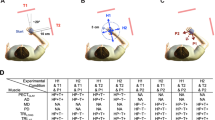Abstract.
Directional tuning is a common finding for many physiological features of arm movements and related neuronal activity. We investigated whether the electromyographic response to a brief (30 ms) torque perturbation prior to voluntary movement depends on the direction of the impending movement. Pointing movements with the elbow joint alone and those involving both the shoulder and elbow joints were studied in separate experiments. Target direction was varied between flexion and extension for the one-joint experiments and among four spatial directions for the two-joint experiments. Movement trials in which a perturbation stretched the flexor muscles just prior to the pointing movement were randomly interspersed among unperturbed movement trials in each experiment. A small pre-load ensured some background activity of the flexor muscles. Results were remarkably similar for the one- and two-joint conditions. The short-latency reflex response of the stretched muscles (in a 30–60 ms window after perturbation onset) was not modulated with direction of target-reaching movement in a statistically significant manner, which confirms earlier findings for one-joint movements and extends these to the two-joint condition. Beyond the short-latency window, the perturbation provoked earlier onsets of target-reaching muscle activities for the agonist muscles, whether or not the muscle had been stretched by the perturbation. The onset of the braking activity of the antagonist muscles also occurred earlier in the presence of the brief perturbation prior to movement, irrespective of whether the muscle had been stretched or not. The magnitude of target-reaching muscle activity, in general, was greater for the perturbed trials, though not consistently for all muscles or all directions. These results suggest that, when movement is about to be initiated, in either single- or multi-joint conditions, the long-latency effects of the stretch strongly depend on the intended direction of movement. The dependence is such that the response serves to hasten and augment the intended movement, but not necessarily to oppose the perturbation.
Similar content being viewed by others
Author information
Authors and Affiliations
Additional information
Electronic Publication
Rights and permissions
About this article
Cite this article
Koshland, G., Hasan, Z. Electromyographic responses to a mechanical perturbation applied during impending arm movements in different directions: one-joint and two-joint conditions. Exp Brain Res 132, 485–499 (2000). https://doi.org/10.1007/s002210000356
Received:
Accepted:
Issue Date:
DOI: https://doi.org/10.1007/s002210000356




